My Outdoor Shelter Evolution
Introduction
I’ve always enjoyed camping since I was a kid going around the country with my brother and parents in an 8’ Open Road slide in truck camper. My personal camping shelter has been an on going evolution driven by wants, needs, and available funds. I’ve developed a good feeling for the advantages and disadvantages of a number of different shelters over the years. Today I still have a number of different shelter options depending on what I feel is best suited for different kinds of trips away from home. These are presented in the order in which they were acquired.
3 Man Backpacking Tent
My first camping shelter once I was on my own was a 3 man dome style tent designed for backpacking. The idea with this tent is that one person carries the tent, another carries the fly and the third carries the fiberglass poles. I went with a dome tent after attending the Riverside Telescope Makers Conference one year where there is a big wind storm at night. I walked around the site the following morning to see what tents had survived the wind storm The only ones that were universally unscathed were the geodetic dome style tents.
The last time this tent was actually used was when I loaned it to some friends who were with me on a trip for some off roading fun around Mammoth Lakes. Our group was base camping at the Crowley Lake Campground which is pretty open. They pitched the tent and put their gear inside thinking that would be sufficient to hold the tent in place. While we were gone for dinner the wind came up and blew the tent with their gear into the next campsite. The tent remained completely intact and all of their gear stayed inside.
This tent served me well for many years when I could only afford occasional car camping trips. I still have it but mostly use it to store extra gear while base camping and to make campsites look occupied when I’m away with my vehicle.
Not my tent by a similar design
 Advantages
Advantages
- Relatively inexpensive
- Lightweight and packs very small
- Enough room for 1 person and stuff
- Self supporting so it can be moved as a unit after setting it up
- Common shelter solution with many options on the marke
- Can provide 3 or 4 season protection
Disadvantages
- Have to pitch and break down the tent when moving to a new spot
- Limited space
- Can’t stand up inside
- Generally not big enough to include a toilet
- Setup can be confusing if not practiced
Teardrop Trailer
In the late ‘90s I started looking at tear drop trailers as something that would get me off of the ground and be more substantial than a tent. Plus I liked the idea of having the permanent rear kitchen area for preparing meals. I never had a vehicle capable of towing a large trailer so a teardrop was a great solution as most any car is capable of towing one.
I had been looking for one on and off for a number of years. I couldn’t afford a new one and the availability of used trailers and disposable income never seemed to align until in 2004 I ran across a vintage 1947 Kit Sportsman teardrop trailer on eBay Motors that was for sale in Pasadena. At the time my primary vehicle was a 2002 PT Cruiser which was perfect for towing a vintage teardrop trailer.
I used the teardrop quite a bit over the next 5 years or so. I still have it and plan to start towing it with the 1947 Hudson Club Coupe I inherited from my father to teardrop trailer meets.
Teardrop trailers have been around since the 1930s and were popular in the 1950s when people became more interested in going places and camping but cars had less power and poor brakes compared to what they they generally do now.
Not My Trailer but Same Model

Vintage 1947 Kit Teardrop Kitchen (Once again not my trailer)

Modern Off Road Teardrop Trailer
 Advantages
Advantages
- More substantial hard sided shelter providing better weather and critter protection
- Some designs include heaters and air conditioners
- Most designs include an open kitchen area in the back which range from very simple to very elaborate
- Just park and level and its ready to go
- Many different designs are available on the market
Disadvantages
- Should monitor CO2 levels sleeping in a relatively small enclosed space
- The inside is completely filled by the bed
- Dirty shoes must be left outside
- You need to be a contortionist to get dressed in one
- The rear hatch may not open high enough for taller people to comfortable use the rear kitchen
- It’s a trailer which can be a real determent in some off road situations
- Some factory built designs are very expensive
Pinzgauer 710M (Sleeping in a van)
I was finally getting to the point in my working life where I started to have enough disposable income to consider getting a fun (toy) vehicle. For years my only big camping trip of the year was to attend the Riverside Telescope Makers Conference (RTMC) at Camp Oaks near Big Bear. One year while in town I saw a couple of Pinzgauers for sale at a local garage. I found them intriguing and the perfect balance of a fun old vehicle and something with off road capability The following year at RTMC I was sitting with my brother and friends over dinner and mentioned going into town to look at the Pinzgauers. No sooner than I said that than someone with a 6x6 Pinzgauer pulled into a spot next to our camp. Of course I was all over it asking a lots of questions.
I was invited to go along with the Southern California Pinzgauer group the following day. After being introduced to the local Pinzgauer community and experiencing them off road I was sold. I had to have one. It took me 3 years but I was finally able to get a Pinzgauer in 2006. Being an old exotic vehicle it’s been a long series of repairs, maintenance, and upgrades to get it to where it is today.
Using the Pinzgauer for shelter is very similar to what you would have in a full size van. The interior is what you make of it. Because my Pinzgauer is a 710M model with a tent like tarp over the cab and back area, albeit double layered with insulation, I chose not to including any cooking facility. It does have a 45 liter electric refrigerator, Zarges cargo boxes for camping gear, recovery gear / spare parts, food, and clothes, and a real bed. Having a bad back a good comfortable supportive bed is a big deal. Finding a good bed has been one of the drivers in my camping shelter evolution.
The Pinzgauer 710M was originally a troop transport capable of carrying 8 people in the back. The seats fold down to make a flat platform capable of holding 2 NATO standard pallets. I have removed the seats on one side where the refrigerator and Zarges boxes are stored. On the other side the seats are folded down providing an approximately 30” wide platform which is perfect for a split queen size mattress. I use a Froli mattress as a box spring and have a custom split queen mattress on top.
The advantages and disadvantages below are oriented around the using a van like vehicle as a shelter rather than being specific to the Pinzgauer as a platform. That could be the topic for another net.
1972 Pinzgauer 710M
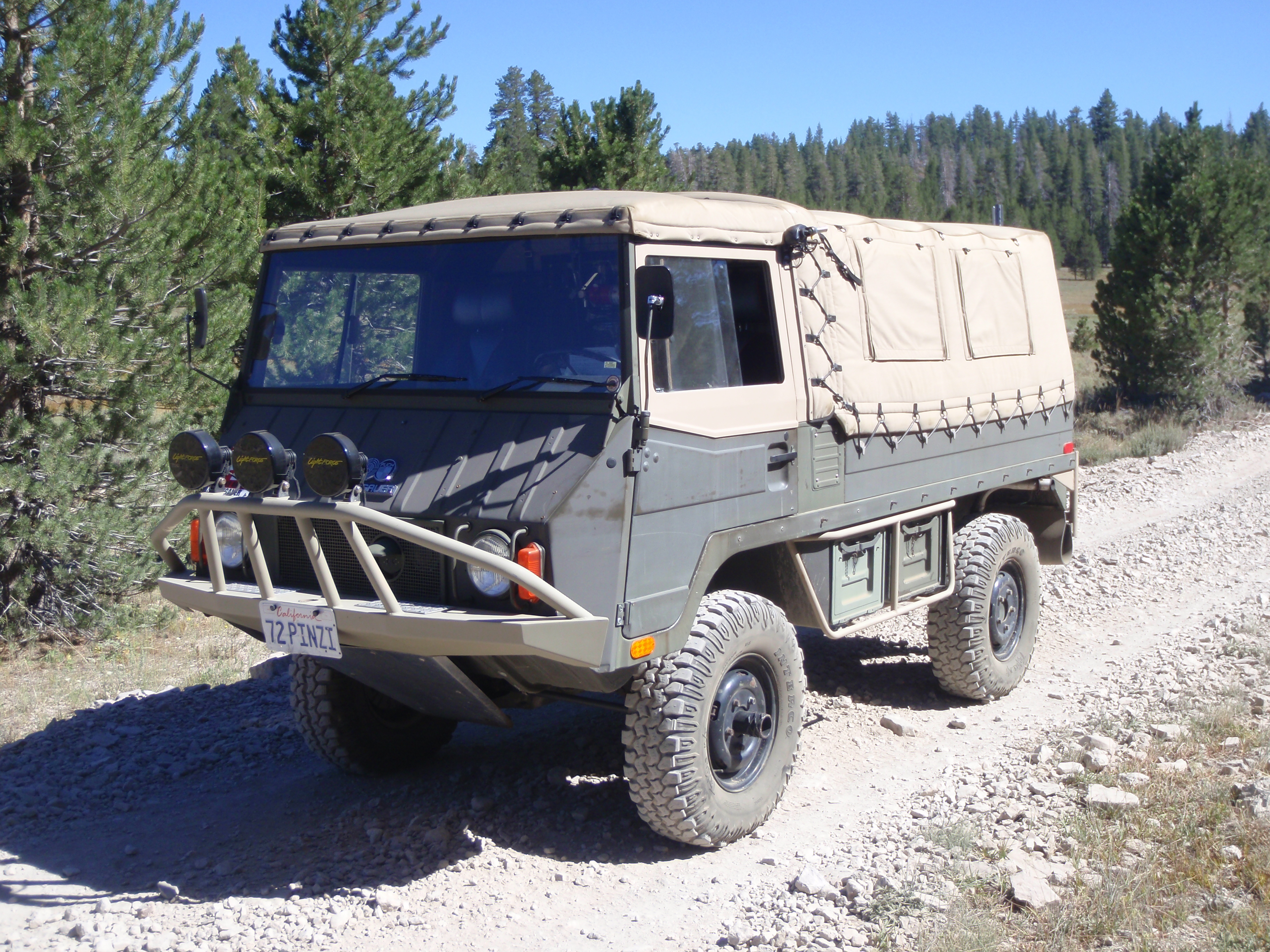
- P8130359.jpg (4.47 MiB) Viewed 8397 times
Pinzgauer Rear Sleeping Area with Storage Boxes and Refrigerator
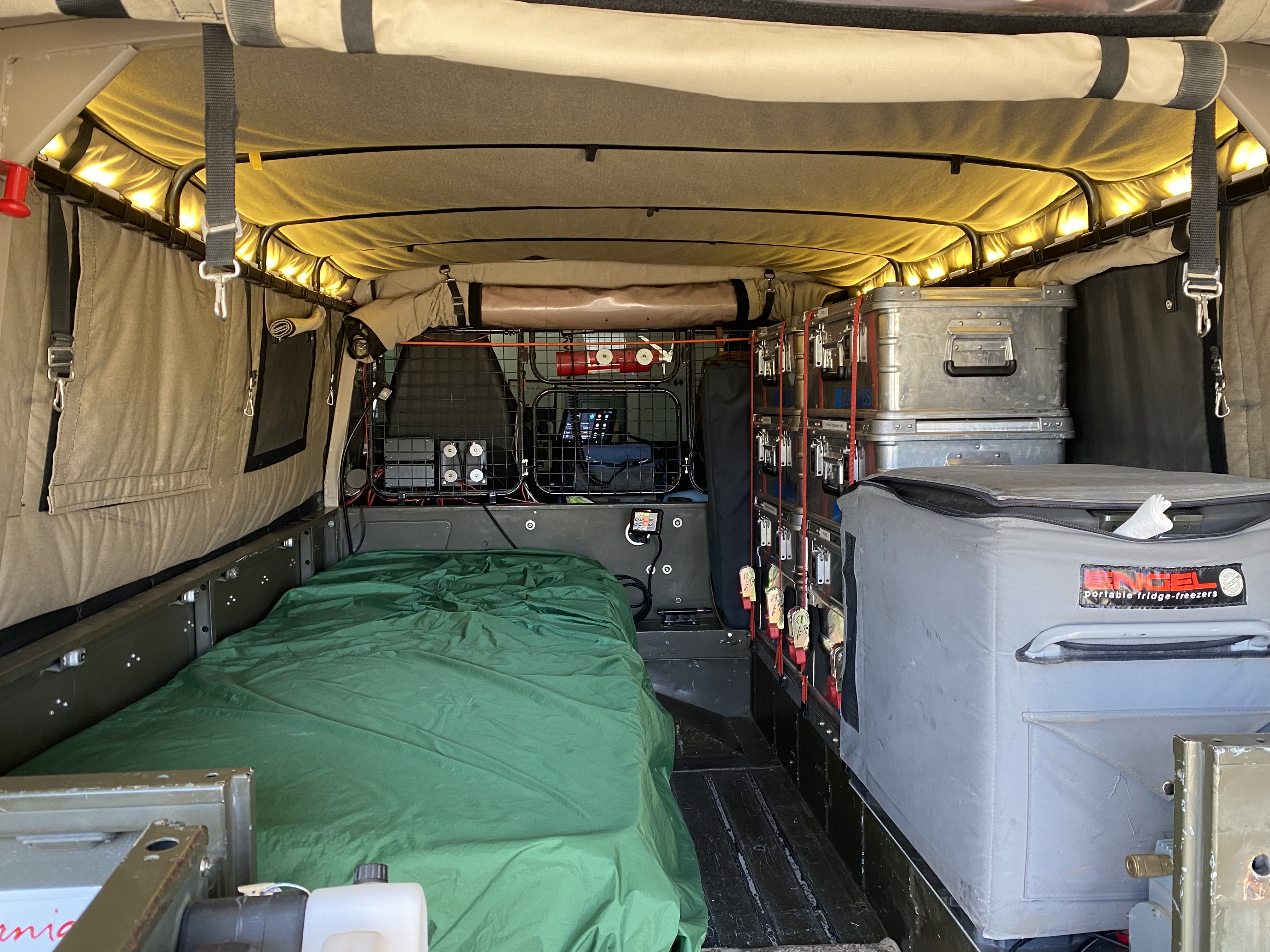
- IMG_2040.jpg (2.37 MiB) Viewed 8397 times
Advantages
- Larger interior space that can accommodate more storage, better bed, kitchen and rudimentary bathroom facilities
- Provides better weather and critter protection than a tent
- A relatively large space to layout as you choose
Disadvantages
- Unless it has a raised roof or pop top you can’t completely stand up inside
- Generally less off road capability (the Pinzgauer is an exception)
- Larger size may limit off road capability in some situations
- Weight and load distribution is important since the larger size makes it easier to overload them
- Factory built adventure vans are very expensive
Oz Tent RV-4
The Pinzgauer is fine as a shelter for one or two people but can’t accommodate any more than that. I was looking for something to support guests while camping and as a car camping upgrade for myself. I read about Oz Tents in Overland Journal and online. I got a chance to see them one year at the Overland Expo. The company showing them was offering good deals late on the last day of the show so I picked one up.
The model I bought is an RV-4 which is their next to the largest model. As the name implies, the Oz Tent is an Australian design. Australians and South Africans have been doing the remote vehicle assisted travel that we call overlanding far longer than we have here in North America. Over the years they have developed a lot of great camping gear.
Development of the Oz Tent came out of a camping trip where the guy who came up with the idea borrowed a tent from a friend and once in the Outback found that his friend forgot to include the tent poles. To prevent this from happening he came up with an idea where the tent fabric, framework, and guy lines are permanently attached to the tent. It’s also called the 30 second tent because once you take it out of it’s bag it only takes about 30 second to open it up. Of course this doesn't include time for site preparation, laying out a ground cloth, or staking out and guying the tent. Still it does eliminate having to figure out where the tent poles go and how they work the first time you try setting it up in the dark.
Basic OZ Tent RV4
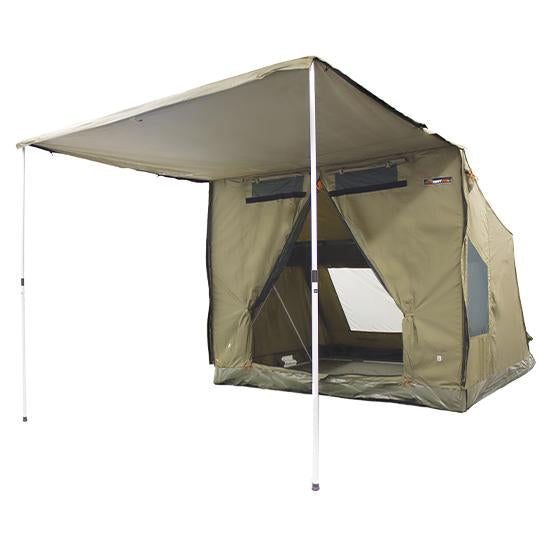
OZ Tent RV4 with awning side panels
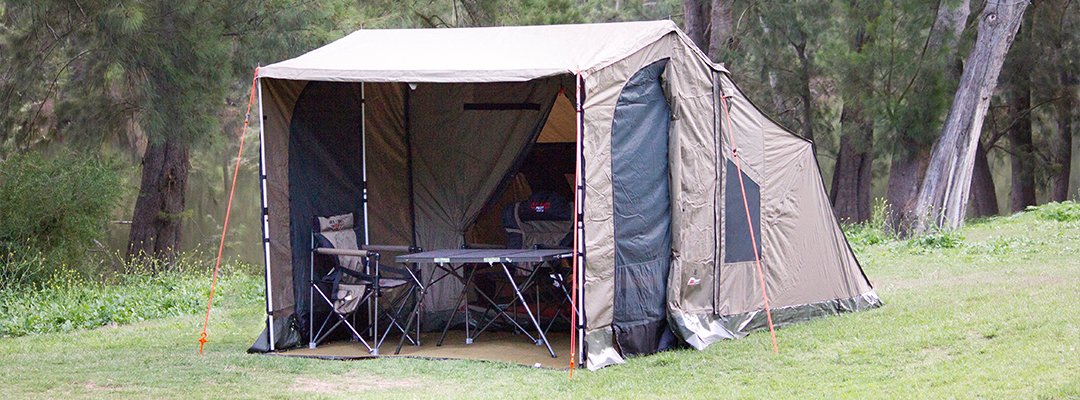 Advantages
Advantages
- Tent frame and most important guy lines are permanently attached to the tent
- Many features optimized for Australian camping conditions
- Tub floor prevents water intrusion on wet ground or rainy conditions
- Tent seals tight to keep out crawling bugs and snakes
- Plenty of ventilation
- Large rear flap opens to provide ventilation even during rain storms
- Permanently attached front awning which may be turned into a second room with zip on side panels.
Disadvantages
- Relatively expensive
- Bulky when packed
- Relative heavy for its size
- While the tent deploys quickly it still needs to be staked down
FlipPac Camper
Many years ago passing through Marina del Ray while riding the South Bay Bicycle Path I saw a truck with a FlipPac camper on the back. It’s basically a bed cap, topper, shell, or what every you want to call it, that sits on top of the sides of a truck bed and is open inside that opens up into a tent. I thought it was a really cool idea and said to myself that if I ever got a pickup truck I’d like to get one.
The unique feature is the that top is hinged at the front and swings open 180 degrees unfurling a tent as it does. The underside of the lid has a mattress attached with Velcro that makes a full or double size bed for sleeping. The rest of the camper is open to the truck bed and the tent provides more than enough height to stand up inside.
To make a long story short, I ended up acquiring a 2004 Toyota Tacoma standard cab 4 wheel drive pickup in 2009 that was purchased new by my uncle in Bend, Oregon. One of the first things I got for the truck was a FlipPac camper. It’s nice to have something more modern, especially a Toyota, when your other off road vehicle is an old exotic maintenance intensive vehicle like a Pinzgauer. The Tacoma is ready to go almost all of the time where there always seems to be something I need to do to the Pinzgauer before taking it out.
At that time FlipPac campers were being sold by Adventure Trailers in Prescott, Arizona. The camper it’s self was being made by Fiberglass Reinforced Products (FRP) in San Bernardo, Califonia to Adventure Trailer’s specifications. The Adventure Trailer FlipPacs eliminated the side windows of the FRP FlipPacs and are supposed to have reinforced fiberglass in some areas.
Unfortunately FRP went out of business so currently no one is producing FlipPac campers. The closest thing on the market is the AT Overland (new name for Adventure Trailers) Habitat. It differs from the FlipPac in that it’s constructed from aluminum rather than fiberglass and the lid is hinged to the rear. This extends the parked footprint of the vehicle but does offer a shaded area under the camper top when opened.
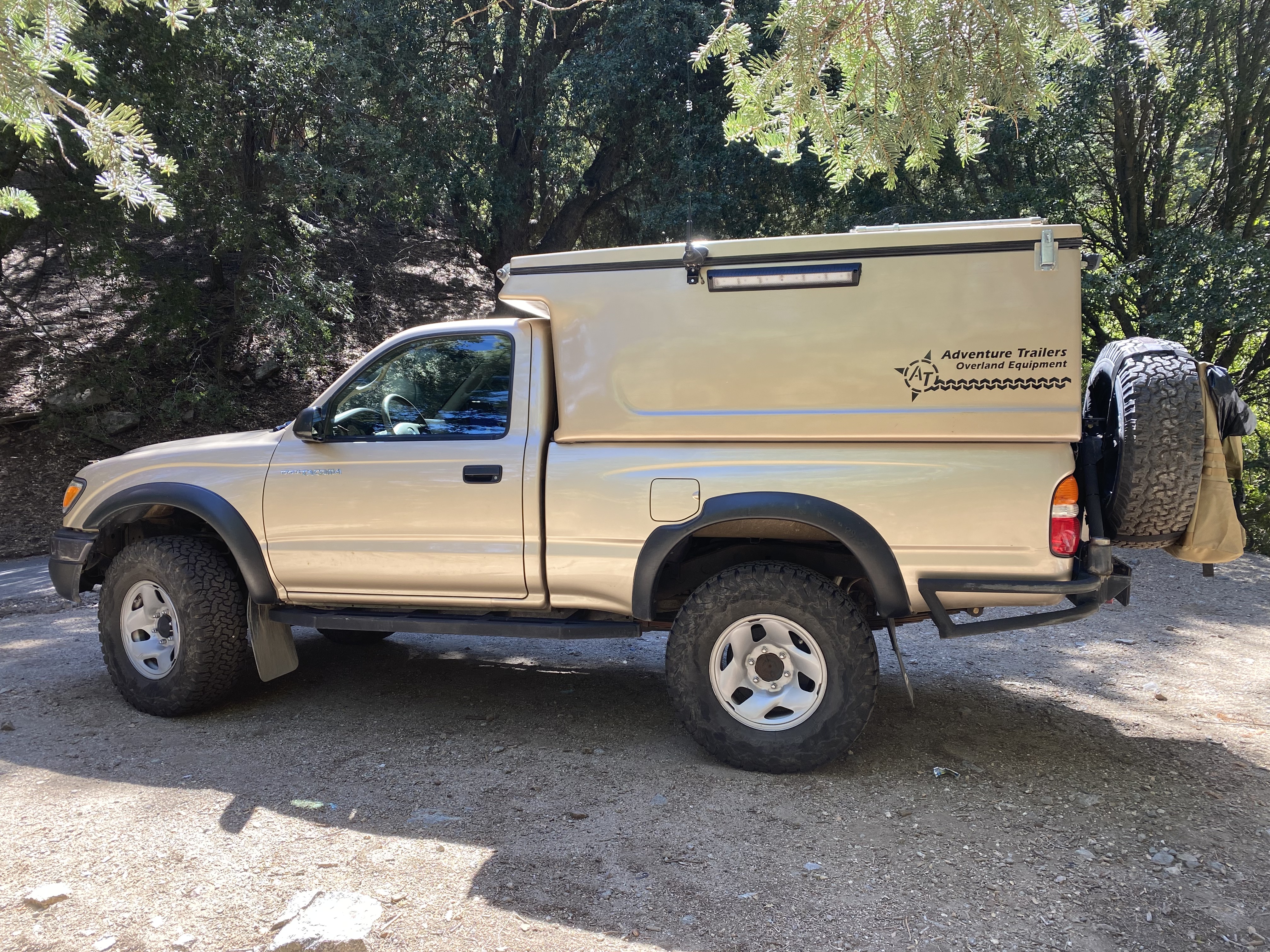
- IMG_1875.jpg (4.16 MiB) Viewed 8398 times
FlipPac Camper Closed
[/list]
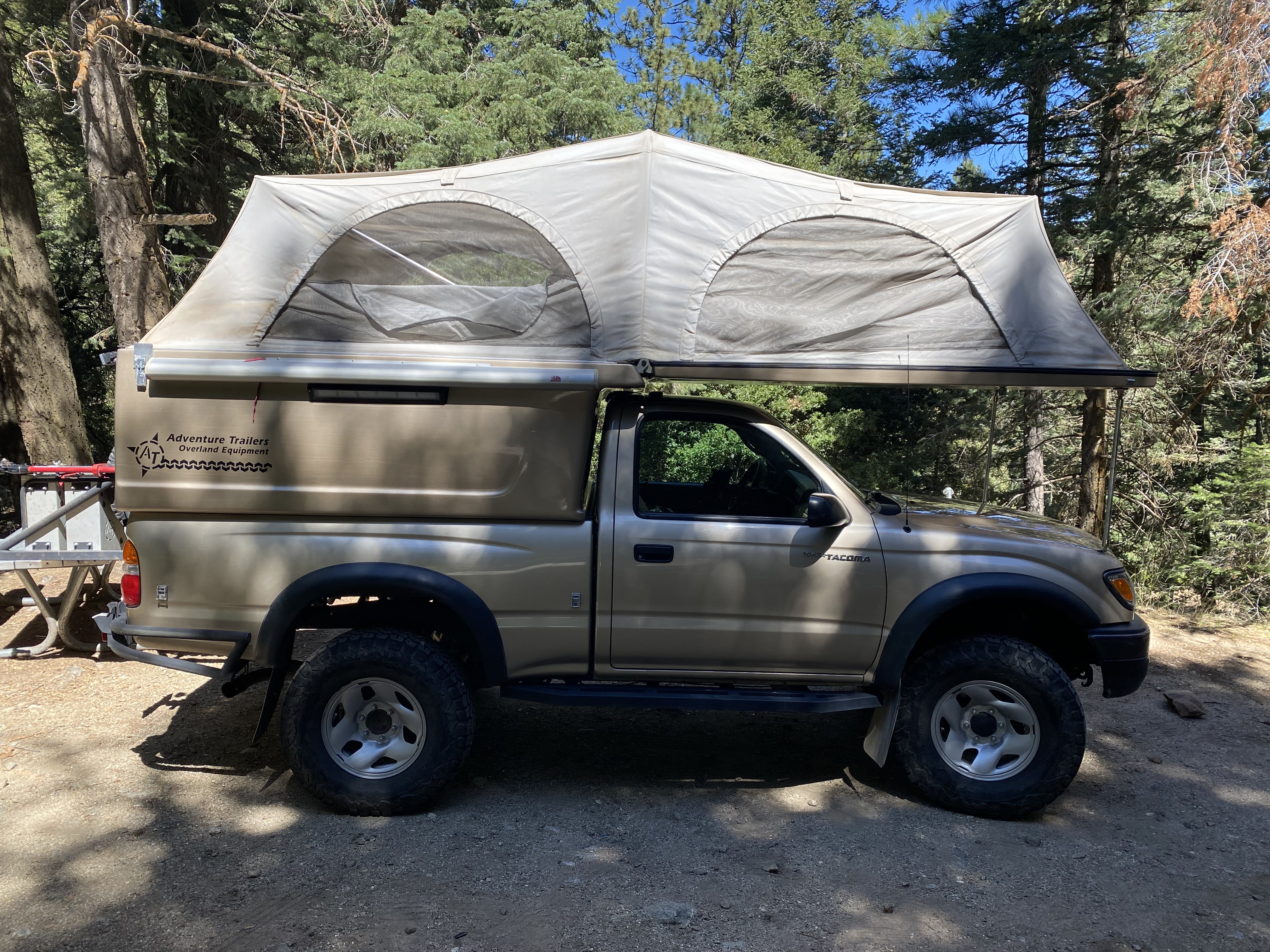
- IMG_1915.jpg (3.9 MiB) Viewed 8398 times
FlipPac Camper Open
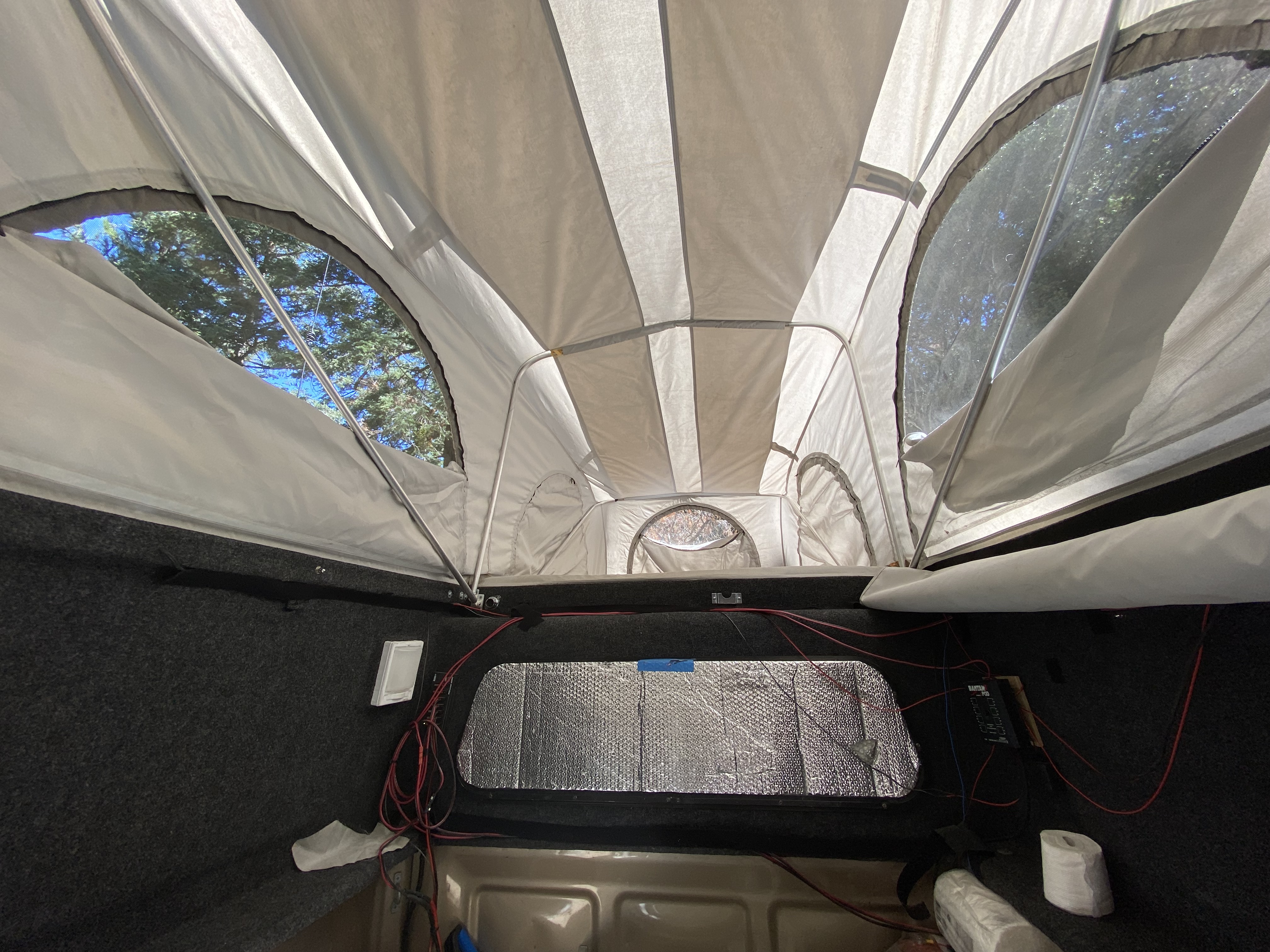
- IMG_1929.jpg (2.76 MiB) Viewed 8398 times
FlipPac Camper Interior
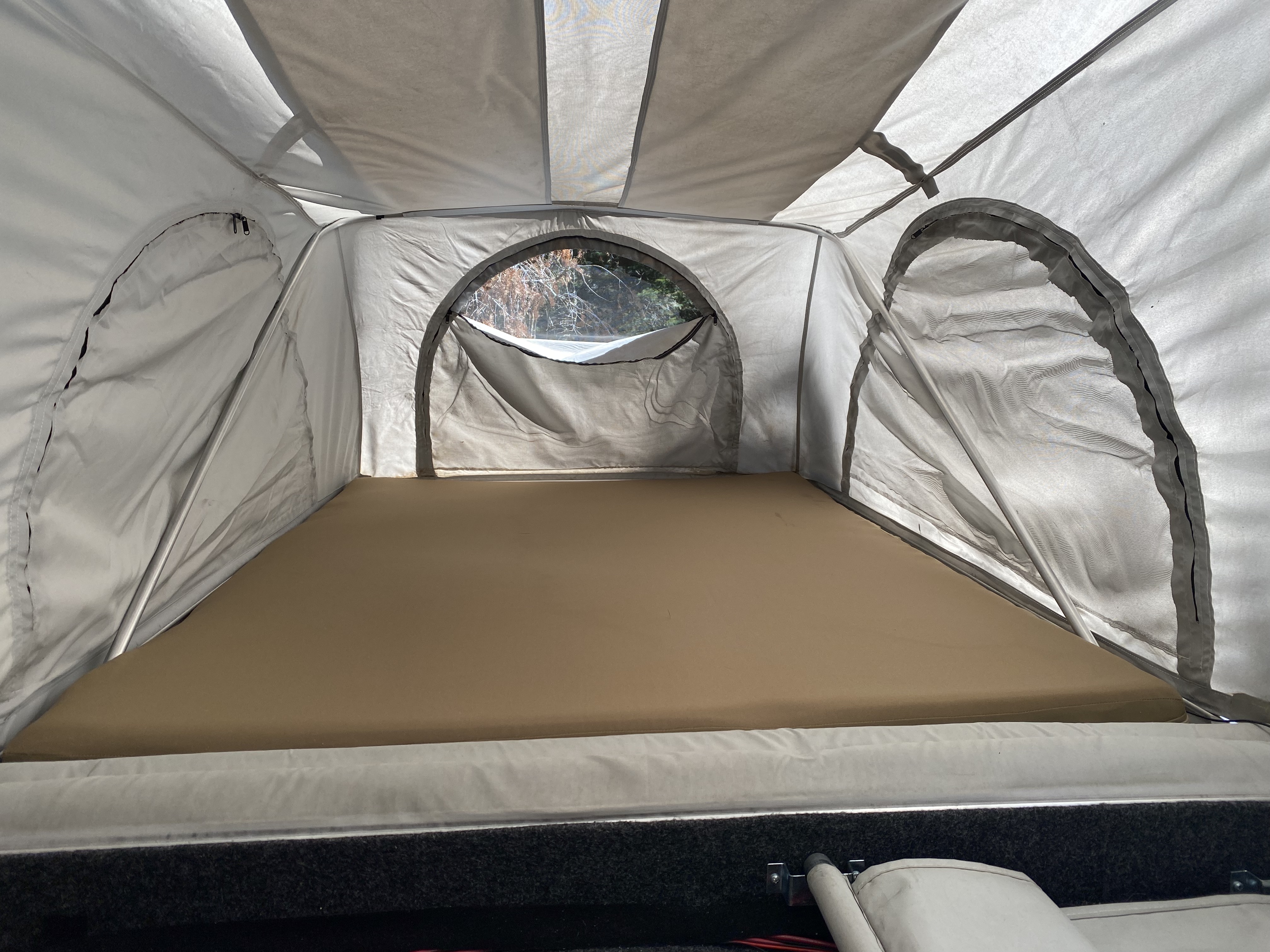
- IMG_1925.jpg (2.48 MiB) Viewed 8398 times
FlipPac Camper Bed

AT Overland Habitat
Advantages
- Provides lots of interior and sleeping space for the folded up size
- Standard size bed makes finding bedding easy
- More than adequate standing room inside
- Light weight compared to other camper options
- Truck bed remains completely open for stprage pr whatever build out you may want
- Large screened opening provide good ventilation for warm weather camping
- Front hinged top means that the open camper does not increase the vehicle footprint
Disadvantages
- FRP is out of business so only used FlipPacs are available
- The torsion bar which assists with opening the lid is prone to castrophic failure
- The top hinges have been prone to rusting
- The top material is full of micro pores requiring a rain fly
- The tent design channels water into the bed area rather than away requiring a rain fly
- Need to crawl over the tailgate getting in and out
DreamCase (Sleeping in Your Vehicle)
This style of camping is more popular in Europe than here but is catching on somewhat due to proliferation of hatchback sedans and cross over SUVs.
DreamCase is a company in Slovenia that started producing custom sleeping systems for Tesla cars. They now offer sleeping systems for other vehicles as well. Other companies offer similar generic or custom sleeping systems for many SUVs here in the US. Many of them use air mattresses rather than the bulky but comfortable foam mattress of the Dreamcase.
Sleeping in your vehicle is very similar to sleeping in a teardrop trailer. Your sleeping platform is completely filled by the bed. In this case it’s created by folding down the 2nd and 3rd seats if applicable and extending into the luggage area. Like a teardrop you need to remove anything your carring inside while it’s configured for sleeping. Where a teardrop may have some shelves or small cabinets the store things, the only available space inside the vehicle with this style of camping is the front seats and the second row foot well area.
The Dreamcase mattress is pretty comfortable but I find that I do tend to bottom out on it. Still I can sleep through the night with no disturbing comfort problems.
Dreamcase camping setup in a Model X
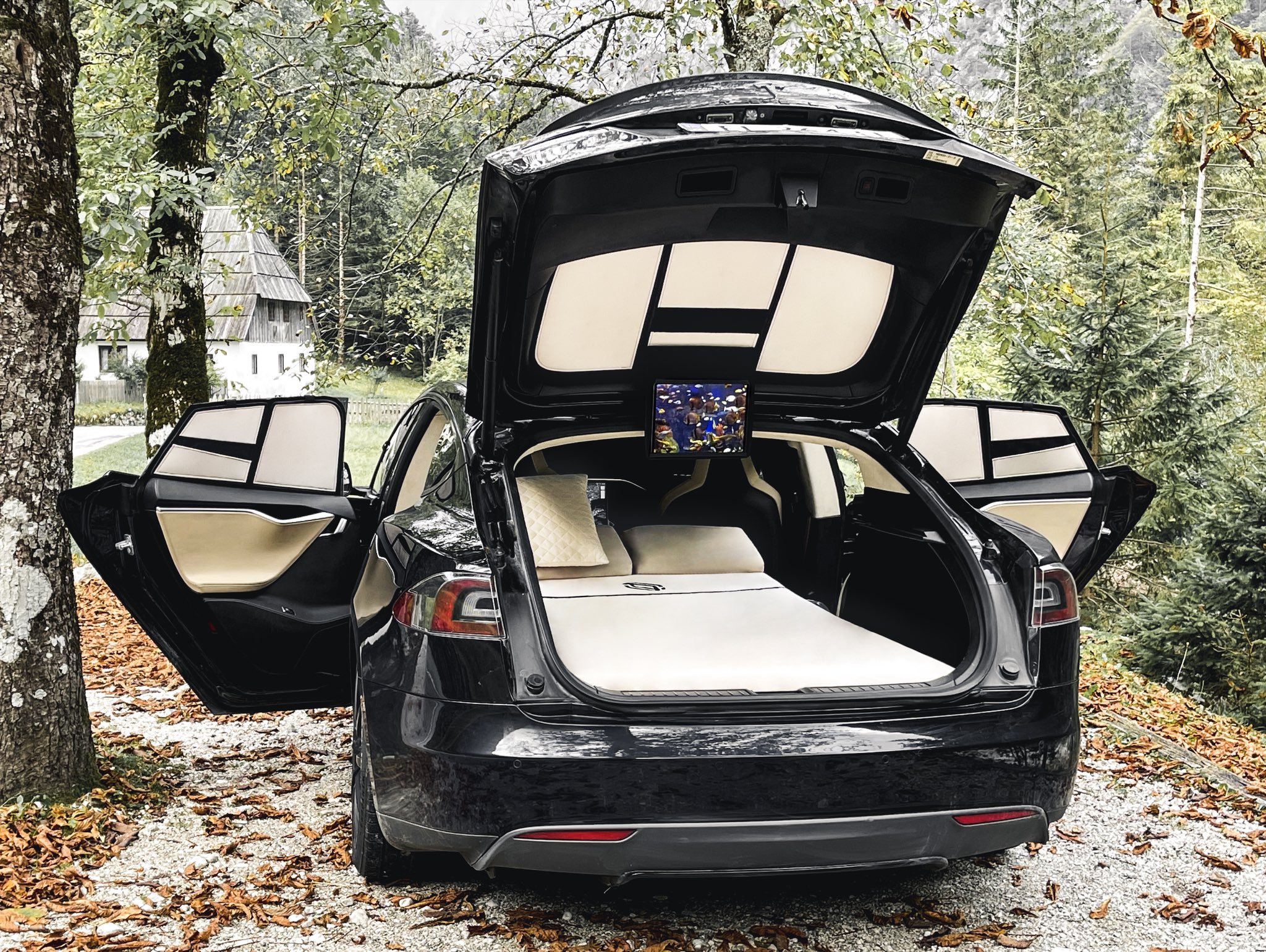
Tesla camping at last year's Borregofest
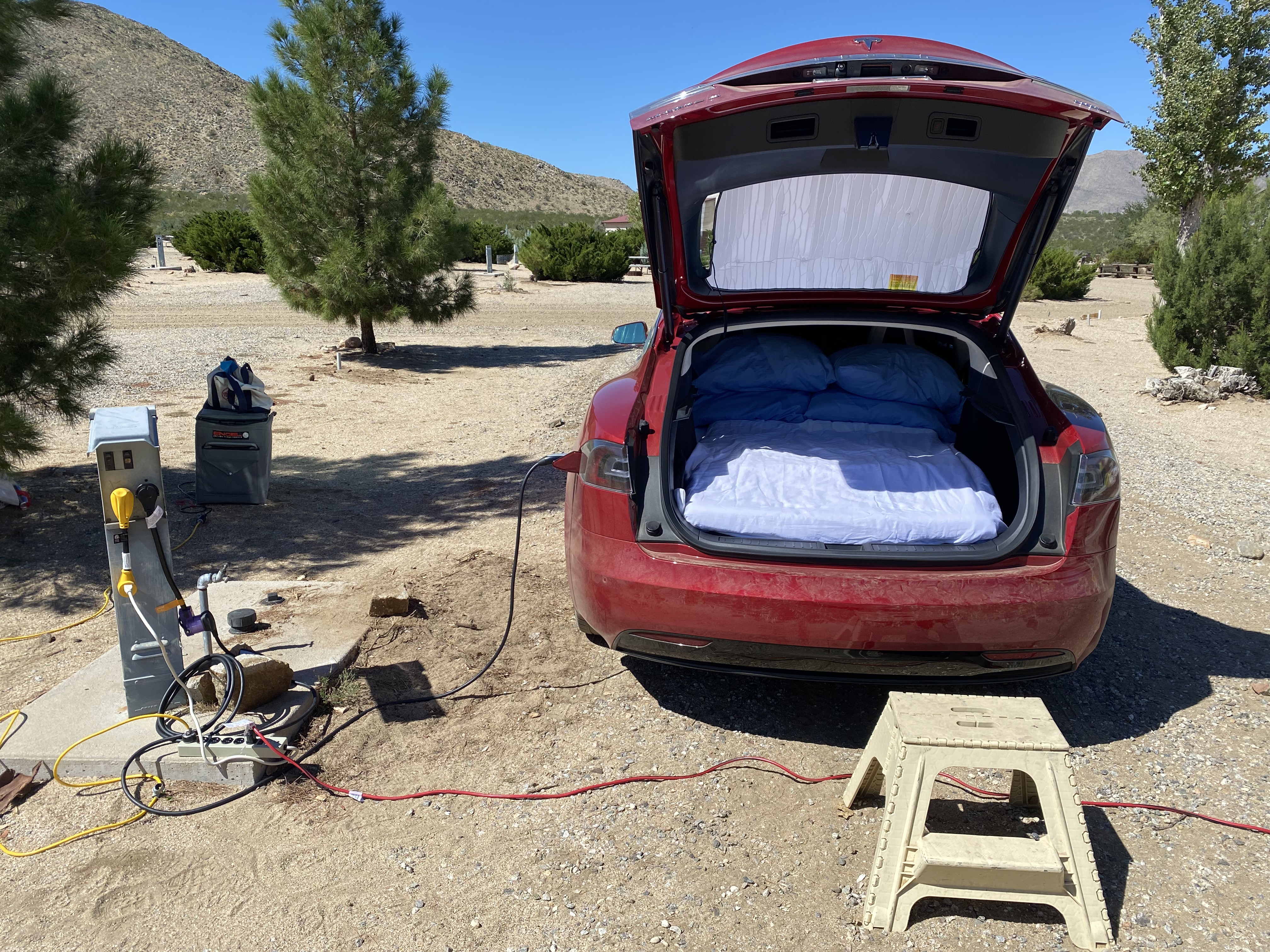
- IMG_0908.jpg (4.44 MiB) Viewed 8396 times
Dreamcase in it's storage box / platform
 Advantages
Advantages
- Provides better protection from weather and critters than a tent
- Many electric vehicles have a camping mode so you have full heating and air conditioning when parked
- Less expensive than a trailer or many tents
Disadvantages
- Same as a tear drop trailer except for expense
- Need something to cover vehicle windows for privacy and light control
- Dreamcase is heavy and bulky when stored in it's box (I leave the supplied pillows out and it's still hard to zipper closed)
Skinny Guy Camper (SGC)
I’ve had the Tacoma with the FlipPac camper in many remote areas and it’s worked great over the years. As much as I liked the FlipPac camper I recently sold it to upgrade to a Skinny Guy Camper. I had always intended to build out the back of the Tacoma and the FlipPac to make it into more of a self contained camper with hot and cold running water, a sink, a space heater, and a more sophisticated electrical system. Unfortunately, last year I needed to have a knee replacement making it difficult to crawl across the tailgate of the Tacoma to get in and out of the FlipPac. I’ve also had increasing back problems the last 6 months which made me have second thoughts about trying to build out the back of the truck myself.
I went to the Overland Expo in Flagstaff earlier this year to look at possibly getting a new off road rig. My dream off road camper would be an Earthcruiser but while they addressed the problems of their earlier units (the topic for another net) the prices have gone way beyond my reach. I was thinking of maybe an adventure van but they are very expensive and don’t have the off road capability to go to many of the places where I’ve taken the Pinzgauer and Tacoma.
What I’d like to see is a modern version of the old Land Rover based Dormobiles. They had a very clever and compact design with a side hinged pop up roof including kitchen, storage, and sleeping all within the footprint of a long wheelbase Landrover. They also retained all of the off road capability of the Landrover. The Hummer EV Earthcruiser comes really close but the price hasn’t been announced and I suspect it will be well north of $200,000. Plus, as much as I like electric vehicles, the Hummer EV is not my idea of the best platform for electric overlanding (possibly the subject of another net).
Landrover Dormobile Exterior

Landrover Dormobile Interior

Hummer EV Earthcruiser Camper

Just days prior to leaving for the Overland Expo I found out about Skinny Guy Campers. They are a very unique design that fits somewhere between a truck bed topper, slide in camper, and roof top tent. Since I appreciate clever designs I made it a point to check them out at the Expo.
I was very impressed with what I saw. They are constructed from 1/8” aluminum. No wood or fiberglass is used. You can get them completely self contained including an RV style flushing toilet, fresh and black water holding tanks, propane stove, combination water and space heater, and electrical system including solar charging, a 1000 Watt 120V inverter, and a shower. They are a very clever and unique design which allows me to continue to use the Tacoma with all of it’s off improvements, modifications, and off road capability.
Like a FlipPac, they are basically a tent on a truck but the tent is made from a more high tech material than what is used on the FlipPac and doesn't require a rain fly. It has an integrated system to manage and capture rain water preventing it from getting into the camper. There is even an optional filtration system that allows you to route rain water into the fresh water holding tank.
The floor of the camper is even with the top of the truck bed. In all but the lowest trim level there is a “basement” that hangs under the floor and houses the fresh and black water tanks along with some of the plumbing, fresh water pump and marine type sewage macerator if equipped. The basement hangs down about 6” leaving the rest of the truck bed underneath open for storage. Many builds include truck bed storage drawers under the SGC. I’m currently working on designing a storage drawer system that will incorporate 2 Dometic CD-30 refrigerators plus storage. I may go with a slide out kitchen in one of the drawers if there is enough height for me to comfortably stand under the open top (maybe the subject of yet another net in the future)
Like all of the other designs with 180 degree opening tops except for the FlipPac, the top is hinged to the back rather than the front and uses gas struts to assist with opening rather than a torsion bar. The enterance to the camper is a tent like zippered flap on the side. The interior is accessed using a roof top tent ladder but it only needs to extend as far as the top of the truck bed.
While SGC lists a wide variety of camper sizes on their website they currently only make 4 different models, the 5.0, 5.0 GLR for the Jeep Gladiator, 5.5, and 6.5 models. The number designates the length of truck bed they are designed to fit. They also plan to offer a native 7.0 model which isn’t currently in production. For other bed lengths such my Tacoma’s 6’ bed or full size 8’ beds their answer is to use the next smaller size unit with a matching storage unit ahead of the camper to fill in the space. I talked with them extensively about this and they feel that the market isn’t big enough to offer native 6’ and 8’ camper unless someone starts offer more trucks in these sizes.
To complicate things, I wanted to go with the 5.0 GLR model on my Tacoma. Even though this unit is specifically designed for a Jeep Gladiator I felt that it would actually be a better fit for my truck bed and offers the advantage of being slightly larger inside since the sides are taller don’t slope in as much as the standard 5.0 model. The holdup on getting the camper is that I need to have a one off storage unit made to match exterior the profile of the 5.0 GLR. Fortunately, SGC works with New Holland Overland to do much of their prototyping work so they are building the storage unit. It should be finished and on its way to SGC this week.
Since interior storage space is very limited I decided not to go with the flushing toilet. My plan is to use the toilet space for storage and utilize a folding Thunder Box with Clean Waste bags for my toilet. I already have the Thunder Box and used it on my last trip. It’s stupid expensive for what it is but it’s extremely well built, works very well, and folds up very thin when not in use. I like it better than the toilet seat on a Homer Bucket I have been using.
Skinny Guy Camper 5.0 GLR Closed
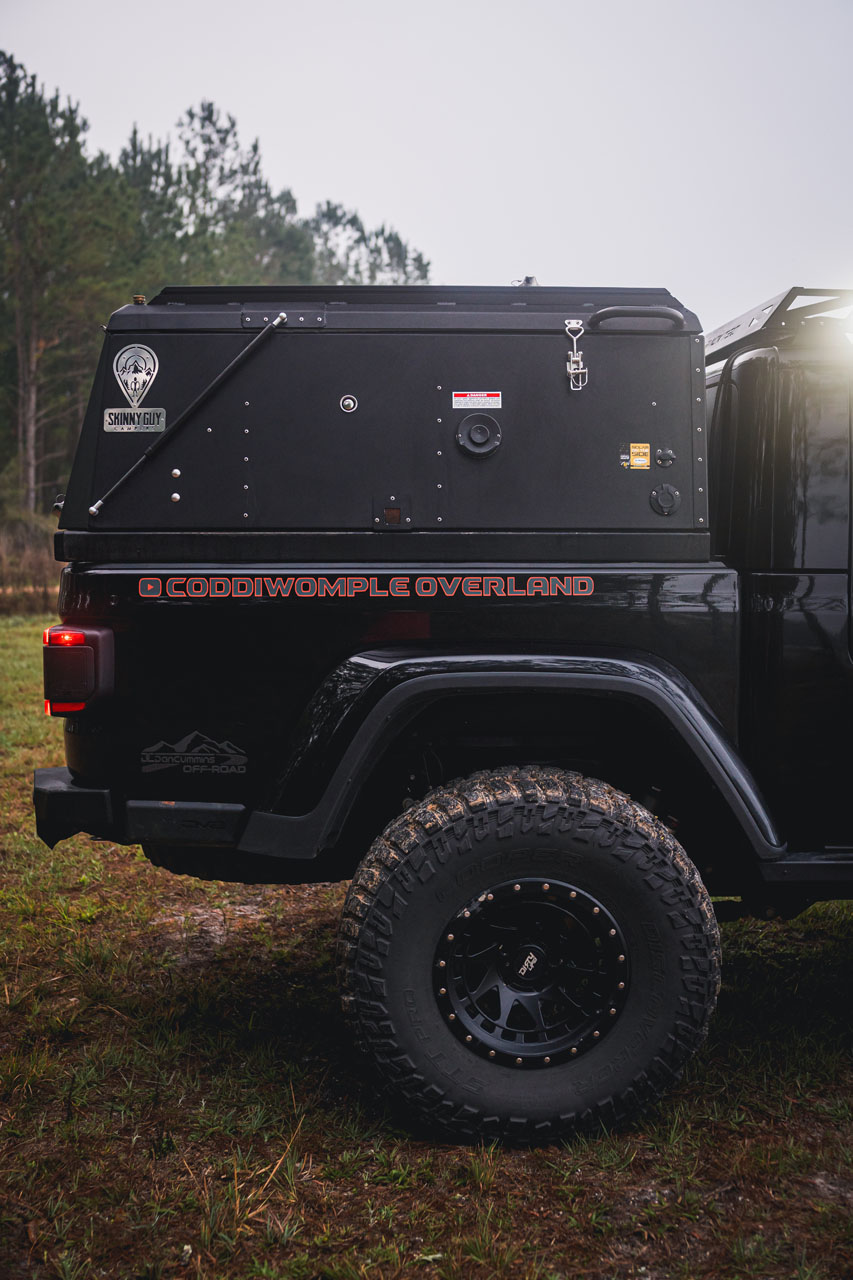
Skinny Guy Camper 5.0 GLR Open

Skinny Guy Camper Interior
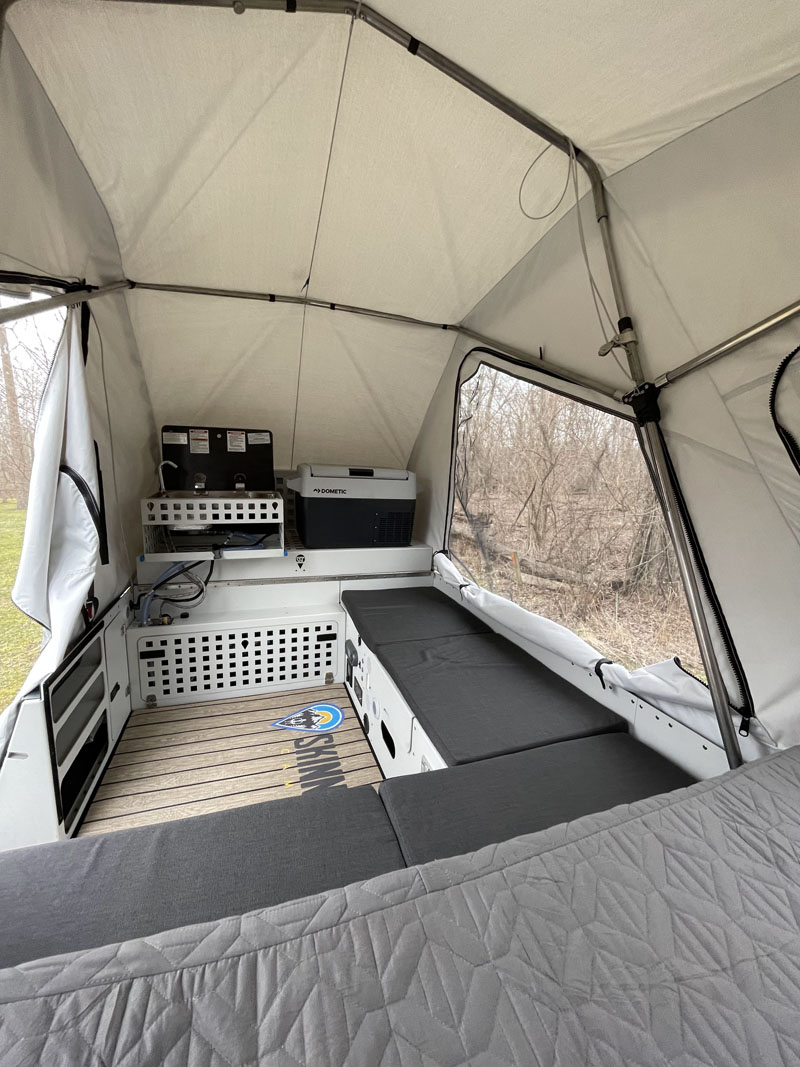
Another image of the Skinny Guy Camper Interior
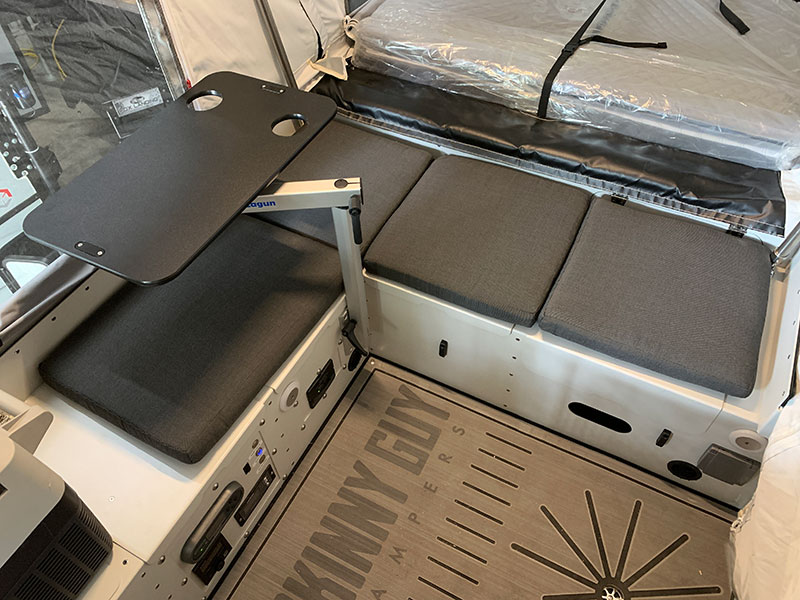
Rear of truck with Skinny Guy Camper showing storage in the truck bed below the camper. The solar panel is facing up when the camper is closed. It slides out and flips up so that it's facing up when the camper is open.
 Advantages
Advantages
- May be fully self contained depending on options
- Substantial aluminum construction
- Side entry with less height than a roof top tent
- Lower center of gravity than a roof top tent
- Standing room inside
- Improved tent fabric compared to a FlipPac
- Full length storage is available in the truck bed under the camper
Disadvantages
- Expensive
- Raises vehicle center of gravity
- Most of the weight is above or high up in the bed
- Heaver than a bed cap or FlipPac camper
- Very limited storage in the camper. Installation on a 6' bed requires an additional storage unit providing additional storage.
- Truck bed storage has limited height. Bed sidewall height minus 6" for the camper "basement"
- Heater and electrical controls are mounted just above floor level
- Interior shower is a work in progress. An extra long hose is provided to shower outside
- Need to lift refrigerator and kitchen unit into place in full size truck units
- 5.0 size truck units do not have enough floor space for the refrigerator when closed
- Rear hinged lid increases vehicle footprint when opened














